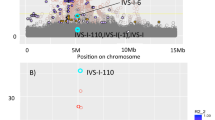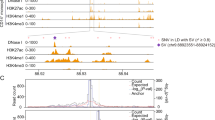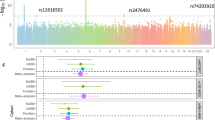Abstract
We report genome-wide association studies for hematological and biochemical traits from ∼14,700 Japanese individuals. We identified 60 associations for 8 hematological traits and 29 associations for 12 biochemical traits at genome-wide significance levels (P < 5 × 10−8). Of these, 46 associations were new to this study and 43 replicated previous reports. We compared these associated loci with those reported in similar GWAS in European populations. When the minor allele frequency was >10% in the Japanese population, 32 (94.1%) and 31 (91.2%) of the 34 hematological loci previously reported to be associated in a European population were replicated with P-values less than 0.05 and 0.01, respectively, and 31 (73.8%) and 27 (64.3%) of the 42 European biochemical loci were replicated.
This is a preview of subscription content, access via your institution
Access options
Subscribe to this journal
Receive 12 print issues and online access
$209.00 per year
only $17.42 per issue
Buy this article
- Purchase on Springer Link
- Instant access to full article PDF
Prices may be subject to local taxes which are calculated during checkout
Similar content being viewed by others
References
Yamaguchi-Kabata, Y. et al. Japanese population structure, based on SNP genotypes from 7003 individuals compared to other ethnic groups: effects on population-based association studies. Am. J. Hum. Genet. 83, 445–456 (2008).
Soranzo, N. et al. A genome-wide meta-analysis identifies 22 loci associated with eight hematological parameters in the HaemGen consortium. Nat. Genet. 41, 1182–1190 (2009).
Thein, S.L. et al. Intergenic variants of HBS1L-MYB are responsible for a major quantitative trait locus on chromosome 6q23 influencing fetal hemoglobin levels in adults. Proc. Natl. Acad. Sci. USA 104, 11346–11351 (2007).
Menzel, S. et al. The HBS1L-MYB intergenic region on chromosome 6q23.3 influences erythrocyte, platelet, and monocyte counts in humans. Blood 110, 3624–3626 (2007).
Ganesh, S.K. et al. Multiple loci influence erythrocyte phenotypes in the CHARGE Consortium. Nat. Genet. 41, 1191–1198 (2009).
Benyamin, B. et al. Common variants in TMPRSS6 are associated with iron status and erythrocyte volume. Nat. Genet. 41, 1173–1175 (2009).
Chambers, J.C. et al. Genome-wide association study identifies variants in TMPRSS6 associated with hemoglobin levels. Nat. Genet. 41, 1170–1172 (2009).
Yip, S.P Sequence variation at the human ABO locus. Ann. Hum. Genet. 66, 1–27 (2002).
Garner, C. et al. Two candidate genes for low platelet count identified in an Asian Indian kindred by genome-wide linkage analysis: glycoprotein IX and thrombopoietin. Eur. J. Hum. Genet. 14, 101–108 (2006).
Maguire, J.M. et al. Polymorphisms in platelet glycoprotein 1balpha and factor VII and risk of ischemic stroke: a meta-analysis. Stroke 39, 1710–1716 (2008).
Dehghan, A. et al. Association of three genetic loci with uric acid concentration and risk of gout: a genome-wide association study. Lancet 372, 1953–1961 (2008).
Kolz, M. et al. Meta-analysis of 28,141 individuals identifies common variants within five new loci that influence uric acid concentrations. PLoS Genet. 5, e1000504 (2009).
Kathiresan, S. et al. Six new loci associated with blood low-density lipoprotein cholesterol, high-density lipoprotein cholesterol or triglycerides in humans. Nat. Genet. 40, 189–197 (2008).
Kathiresan, S. et al. Common variants at 30 loci contribute to polygenic dyslipidemia. Nat. Genet. 41, 56–65 (2009).
Saxena, R. et al. Genome-wide association analysis identifies loci for type 2 diabetes and triglyceride levels. Science 316, 1331–1336 (2007).
Yuan, X. et al. Population-based genome-wide association studies reveal six loci influencing plasma levels of liver enzymes. Am. J. Hum. Genet. 83, 520–528 (2008).
Nose, J., Saito, A. & Kamatani, N. Statistical analysis of the associations between polymorphisms within aldehyde dehydrogenase 2 (ALDH2), and quantitative and qualitative traits extracted from a large-scale database of Japanese single-nucleotide polymorphisms (SNPs). J. Hum. Genet. 53, 425–438 (2008).
Bagnasco, S.M., Peng, T., Janech, M., Karakashian, A. & Sands, J. Cloning and characterization of the human urea transporter UT-A1 and mapping of the human Slc14a2 gene. Am. J. Physiol. Renal Physiol. 281, F400–F406 (2001).
Aulchenko, Y.S. et al. Loci influencing lipid levels and coronary heart disease risk in 16 European population cohorts. Nat. Genet. 41, 47–55 (2009).
Sabatti, C. et al. Genome-wide association analysis of metabolic traits in a birth cohort from a founder population. Nat. Genet. 41, 35–46 (2009).
Melzer, D. et al. A genome-wide association study identifies protein quantitative trait loci (pQTLs). PLoS Genet. 4, e1000072 (2008).
Harmon, J.T. & Jamieson, G.A. The glycocalicin portion of platelet glycoprotein Ib expresses both high and moderate affinity receptor sites for thrombin. A soluble radioreceptor assay for the interaction of thrombin with platelets. J. Biol. Chem. 261, 13224–13229 (1986).
Ware, J. et al. Nonsense mutation in the glycoprotein Ib alpha coding sequence associated with Bernard-Soulier syndrome. Proc. Natl. Acad. Sci. USA 87, 2026–2030 (1990).
Miller, J.L., Cunningham, D., Lyle, V.A. & Finch, C.N. Mutation in the gene encoding the alpha chain of platelet glycoprotein Ib in platelet-type von Willebrand disease. Proc. Natl. Acad. Sci. USA 88, 4761–4765 (1991).
Wiestner, A., Schlemper, R., van der Maas, A. & Skoda, R. An activating splice donor mutation in the thrombopoietin gene causes hereditary thrombocythaemia. Nat. Genet. 18, 49–52 (1998).
Shu, L., Yan, W. & Chen, X. RNPC1, an RNA-binding protein and a target of the p53 family, is required for maintaining the stability of the basal and stress-induced p21 transcript. Genes Dev. 20, 2961–2972 (2006).
Wohlschlegel, J.A. et al. Inhibition of eukaryotic DNA replication by geminin binding to Cdt1. Science 290, 2309–2312 (2000).
Kozar, K. et al. Mouse development and cell proliferation in the absence of D-cyclins. Cell 118, 477–491 (2004).
Yamaguchi, H. et al. Mutations in TERT, the gene for telomerase reverse transcriptase, in aplastic anemia. N. Engl. J. Med. 352, 1413–1424 (2005).
Fischer, E.H., Charbonneau, H. & Tonks, N.K. Protein tyrosine phosphatases: a diverse family of intracellular and transmembrane enzymes. Science 253, 401–406 (1991).
Castigli, E. et al. TACI is mutant in common variable immunodeficiency and IgA deficiency. Nat. Genet. 37, 829–834 (2005).
Salzer, U. et al. Mutations in TNFRSF13B encoding TACI are associated with common variable immunodeficiency in humans. Nat. Genet. 37, 820–828 (2005).
Inazu, A. et al. Increased high-density lipoprotein levels caused by a common cholesteryl-ester transfer protein gene mutation. N. Engl. J. Med. 323, 1234–1238 (1990).
Ichida, K. et al. Age and origin of the G774A mutation in SLC22A12 causing renal hypouricemia in Japanese. Clin. Genet. 74, 243–251 (2008).
Nakamura, Y. The BioBank Japan project. Clin. Adv. Hematol. Oncol. 5, 696–697 (2007).
Price, A.L. et al. Principal components analysis corrects for stratification in genome-wide association studies. Nat. Genet. 38, 904–909 (2006).
Whitehead, A. Combining estimates of a treatment difference across trials. in Meta-Analysis of Controlled Clinical Trials (Wiley, Chichester, UK, 2002).
Higgins, J.P., Thompson, S.G., Deeks, J.J. & Altman, D.G. Measuring inconsistency in meta-analyses. Br. Med. J. 327, 557–560 (2003).
The International HapMap Consortium. A second generation human haplotype map of over 3.1 million SNPs. Nature 449, 851–861 (2007).
Purcell, S. et al. PLINK: a tool set for whole-genome association and population-based linkage analyses. Am. J. Hum. Genet. 81, 559–575 (2007).
Acknowledgements
We thank the technical staff of the Laboratory for Genotyping Development at RIKEN for SNP genotyping and K. Kamatani for useful advice about statistical analyses. We also thank all the participants and the staff of the BioBank Japan project. This study was supported by the Ministry of Education, Culture, Sports, Science, and Technology, Japan.
Author information
Authors and Affiliations
Contributions
Y.K., K.M., M.K. and N.K. designed the study; Y.N. managed BioBank Japan; M.K. and N.H. conducted genotyping experiments and quality control; Y.K., Y.O. and N.K. performed the statistical analysis; Y.K., Y.O., K.M., M.K., Y.D. and N.K. wrote the manuscript; Y.N. obtained the funding for the study.
Corresponding author
Ethics declarations
Competing interests
The authors declare no competing financial interests.
Supplementary information
Supplementary Text and Figures
Supplementary Figures 1–3 and Supplementary Tables 1–4 (PDF 2758 kb)
Rights and permissions
About this article
Cite this article
Kamatani, Y., Matsuda, K., Okada, Y. et al. Genome-wide association study of hematological and biochemical traits in a Japanese population. Nat Genet 42, 210–215 (2010). https://doi.org/10.1038/ng.531
Received:
Accepted:
Published:
Issue Date:
DOI: https://doi.org/10.1038/ng.531



